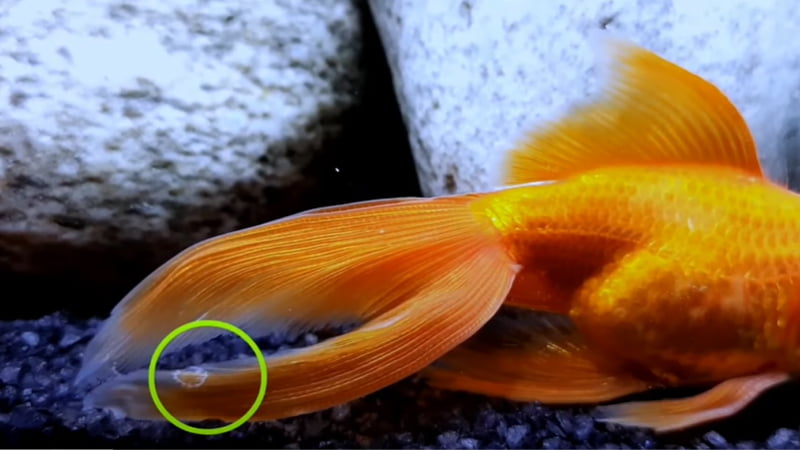Goldfish are popular pets known for their vibrant colors, playful personalities, and ease of care. However, they are also susceptible to various health problems, one of which is Goldfish Fin Rot. This condition can cause serious harm to your pet and can even be life-threatening if left untreated. Goldfish Fin Rot is a bacterial infection that affects the fins of your fish, and it is important to understand the causes, symptoms, and treatments to ensure the health and well-being of your pet.
In this blog post, we will take an in-depth look at Goldfish Fin Rot, from its causes and symptoms to the steps you can take to prevent it and keep your fish healthy. Whether you are a seasoned goldfish owner or new to the hobby, this information will be invaluable in keeping your pet happy and healthy.
See also:
- Clownfish Fin Rot: Top 6 Important Things You Need To Know
- Why Goldfish Laying On Bottom Of The Tank? 8 Reasons That You Should Beware
- Swim Bladder Disease Clownfish (3 Symptoms And Helpful Cure)
Quick Introduction To Goldfish Fin Rot
Fin Rot is a condition that affects fish, either as a symptom of an underlying disease or as the primary disease itself. This condition is most commonly seen in aquariums and aquaculture settings, but it can also occur in natural populations.
Fin Rot is caused by either a bacterial infection (such as Pseudomonas fluorescens), which leads to the ragged rotting of the fins, or a fungal infection, which results in a more even rotting of the fins and is often accompanied by a white edge. In some cases, both bacterial and fungal infections may occur simultaneously. The primary factors that lead to the onset of Fin Rot include poor water conditions, injury, stress, and poor diet.
The disease progresses from the edges of the fins towards the base, and if left untreated, it can eventually reach the fin base and destroy the tissue, making it impossible for the fish to regenerate the lost tissue. When the disease reaches this advanced stage, it can also begin to affect the fish’s body, a condition referred to as advanced Fin and Body Rot.
Fin Rot is a common disease not only in goldfish but also in other kinds of fish such as betta fish due to the poor water conditions often found in pet stores. It is important to monitor the health of your fish and take the necessary steps to prevent and treat Fin Rot in fish to ensure the well-being of your pet.
Symptoms Of Fin Rot In Goldfish
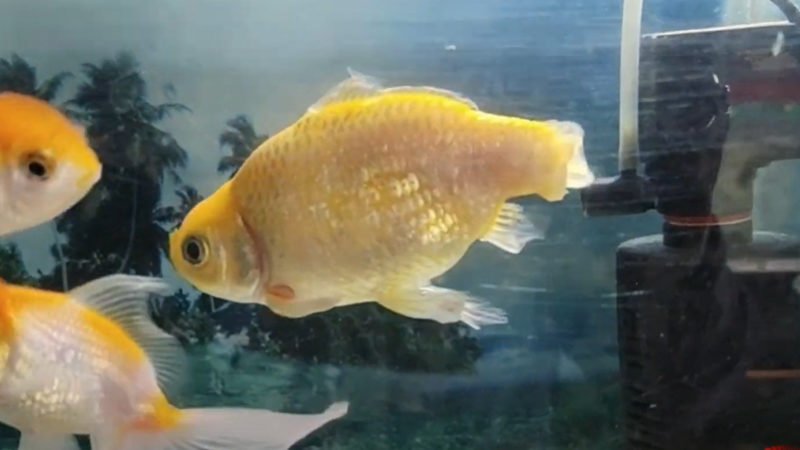
Fin Rot is a common disease affecting goldfish, and it is essential to recognize the symptoms early on to ensure prompt treatment and prevent the spread of the disease. Here is a comprehensive guide to the Fin Rot symptoms in goldfish, and what to look for if you suspect that your fish has Fin Rot.
- Ragged or frayed fins: One of the earliest and most noticeable signs of Fin Rot is a change in the appearance of the fins and tail. If the fins become ragged or frayed, this can be a sign that the disease has already begun to take hold. The fins may appear to have small tears or breaks, and the edges may look tattered or frayed.
- Darkening of the fins: Another early symptom of Fin Rot is a darkening or discoloration of the fins. This discoloration can occur along the edges of the fins or over the entire fin. The discoloration may be brown, black, or gray, and it can indicate that the disease is spreading and destroying tissue.
- Fin loss: As Fin Rot progresses, the fish may begin to lose its fins, and the fin tissue may become translucent or disappear completely. In severe cases, the fins may become completely shredded or disappear entirely, leaving only the fin rays behind.
- Body and tail rot: If the Fin Rot is not treated in its early stages, it can spread to the body and tail of the fish, leading to body and tail rot. This can cause the skin to become discolored, and the scales may become raised or lose their normal appearance. In severe cases, the skin may become ulcerated, and the flesh may become exposed, creating a breeding ground for secondary infections.
- Decreased appetite: In addition to the physical symptoms of Fin Rot, the fish with Fin Rot may also show a decreased appetite or reluctance to feed. This can be a sign of discomfort or pain, and it can also indicate that the fish is not feeling well.
- Decreased activity: Fin Rot can also cause the fish to become lethargic and show a decrease in activity. The fish may seem to be swimming slowly or may spend more time resting at the bottom of the aquarium or pond.
Factors That Cause Fin Rot Disease In Your Fish
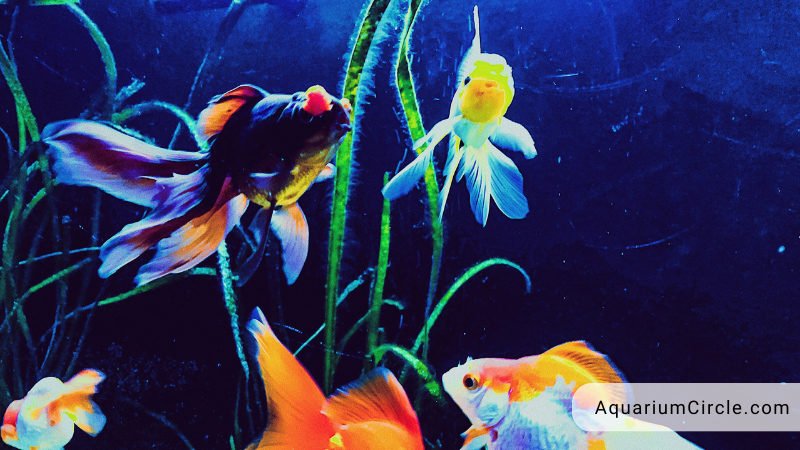
After being aware of what are the first indications of Fin Rot in goldfish, let’s figure out the common causes of the Fin Rot in your goldfish.
Goldfish Fin Rot can be caused by several factors, including:
Poor water quality
Poor water quality is a common cause of Fin Rot in goldfish. Goldfish are heavy waste producers, and without proper filtration and water changes, the levels of nitrogen compounds and other pollutants in the water (for example ammonia, nitrate, nitrite) can quickly reach dangerous levels. High levels of pollutants can create an ideal environment for harmful bacteria, including those that cause Fin Rot, to flourish.
In addition to high levels of pollutants, poor water quality can also result from other factors such as high pH levels, low oxygen levels, and fluctuating temperatures. These conditions can further weaken the fish’s immune system and increase the risk of disease.
Overcrowding
Overcrowding can result in Fin Rot in goldfish for several reasons:
- Poor water quality: Overcrowding can lead to poor water quality as the amount of waste produced by the fish increases, leading to a buildup of harmful chemicals such as ammonia and nitrite. The poor water quality can weaken the fish’s immune system and make it more susceptible to infections, including Fin Rot.
- Increased stress levels: Overcrowded conditions can cause increased stress levels in goldfish, leading to a weakened immune system and increased vulnerability to diseases like Fin Rot. Goldfish may become territorial and aggressive, which can increase stress levels, and reduce their immunity.
- Spread of disease: Overcrowding can also increase the spread of diseases and parasites among the fish, including Fin Rot. The disease can quickly spread from one fish to another in a crowded environment, leading to a higher likelihood of infection.
- Reduced swimming space: Overcrowding can also reduce the amount of swimming space available for the fish, leading to increased stress levels and decreased physical activity, which can weaken the immune system and increase the risk of Fin Rot.
See also: Can Goldfish Live Alone? Let’s Find Out What Goldfish Really Feel Like When They’re Lonely
Stress
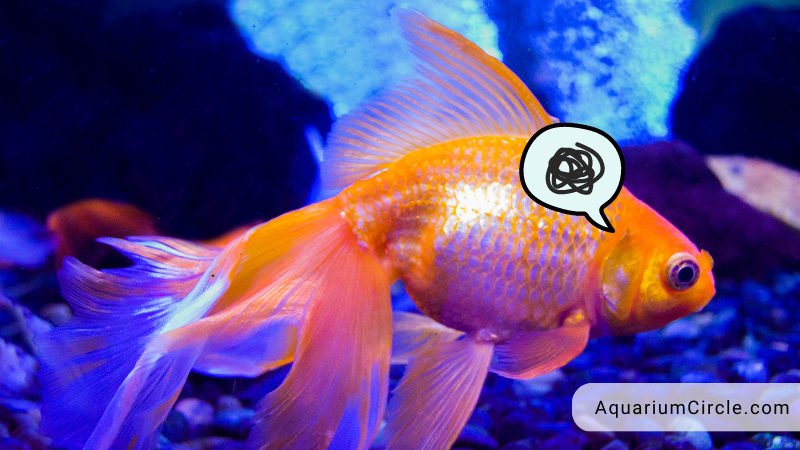
Stress is one of the many factors that can trigger Fin Rot in goldfish. Stress can weaken the fish’s immune system, making it more vulnerable to infections and diseases, also boosting the development of Fin Rot. Some of the most common stress-inducing factors in goldfish include:
- Poor water quality: Poor water quality can cause stress in goldfish. Ammonia, nitrite, and nitrate levels that are too high, pH that is too low or high, and temperature fluctuations can all cause stress in goldfish.
- Overcrowding: Putting the fish together with many aggressive tank mates in the aquarium or pond can cause stress in goldfish. The sick fish may become territorial or aggressive, leading to stress and decreased immunity.
- Unfamiliar environments: Moving the goldfish to a new environment can cause stress, especially if the new environment is significantly different from the previous one.
- Handling and transport: Handling and transporting the goldfish can cause stress. The fish may become frightened or disoriented, leading to increased stress levels.
- Lack of hiding places: If there are not enough hiding places in the aquarium or pond, the goldfish may become stressed, leading to a weakened immune system.
Injuries
As a fan of Fancy Goldfish, it is imperative to be mindful of their heightened vulnerability to injury. The stunning appearance of species such as Fantail and Veiltail Goldfish, with their delicate and flowing fins, unfortunately, makes them more susceptible to harm. Equally, Oranda Goldfish and Telescope Eye Goldfish are also at risk, as their tendency to swim into surfaces while in their aquatic habitat increases their chances of incurring injury.
It is essential to consider any object or surface within your fish tank that may potentially cause harm to your pet through cuts, scrapes, or other injuries. Such occurrences not only inflict pain upon the fish but also provide a pathway for bacteria in the water to gain access to the fish’s body, leading to potential infection. It is imperative to maintain a safe and hygienic environment for your aquatic pets to minimize the risk of injury and promote their overall health and well-being.
Poor diet
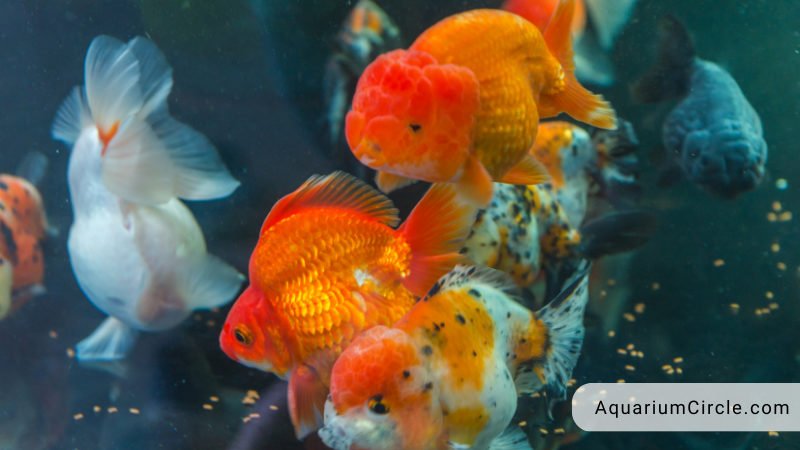
A poor diet can be a contributing factor in the development of fin rot in goldfish. Inadequate nutrition can weaken the fish’s immune system, making them more susceptible to bacterial or fungal infections. A fish food that is deficient in vitamins, minerals, and essential fatty acids can also impact the fish’s ability to properly heal from any injuries they may incur, further increasing their risk of fin rot.
Additionally, feeding goldfish a diet that consists mainly of low-quality foods, such as flake food or freeze-dried options, can result in digestive problems that can cause stress and weaken the fish’s overall health. This can also result in the buildup of harmful waste products in the fish tank, which can further contribute to the growth of harmful bacteria and increase the risk of infection.
Overfeeding
Overfeeding can also lead to fin rot in goldfish. When goldfish are overfed, they produce more waste, which can cause an increase in harmful bacteria levels in the fish tank. This can lead to poor water quality, which is one of the main causes of fin rot. In addition, overfeeding can cause digestive problems in goldfish, leading to bloating, constipation, and a weakened immune system, all of which increase the risk of fin rot.
Moreover, uneaten food that remains in the water can release harmful chemicals and decompose, leading to the depletion of dissolved oxygen levels and an increase in toxic ammonia levels. This can cause stress and weaken the fish’s overall health, making them more susceptible to bacterial or fungal infections.
How To Treat Fin Rot In Goldfish?
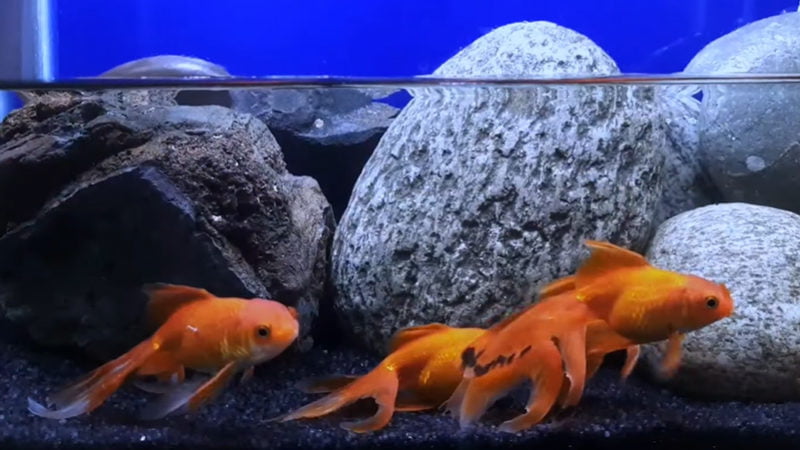
If you suspect that your goldfish is suffering from fin rot, it is important to take immediate action in order to prevent the condition from worsening. Here are some Fin Rot treatments you can take to cure fin rot in goldfish:
- Improve Water Quality: One of the most common causes of fin rot in goldfish is poor water quality, so it is essential to ensure that the water in your fish tank is clean and healthy. This can be achieved by regularly performing partial water changes, and ensuring that the water temperature, pH levels, and other water parameters are within the appropriate range for your goldfish.
- Reduce Stress: Stress is a major factor that can trigger or worsen fin rot, so it is important to reduce stress in your goldfish as much as possible. This can be done by providing your fish with a peaceful environment, avoiding overcrowding, and avoiding any sudden changes to the environment.
- Provide Proper Diet: A proper diet is essential for the overall health of your goldfish, and a poor diet can contribute to fin rot. Ensure that your goldfish is receiving a balanced and varied diet, and avoid overfeeding, which can lead to excess waste and contribute to poor water quality.
- Use Antibiotics: If the fin rot is caused by a bacterial infection, antibiotics can be used to treat the condition. Antibiotics can be purchased at your local pet store, or prescribed by a veterinarian. It is important to follow the instructions carefully when administering antibiotics to your goldfish.
- Clean the Tank: Regularly cleaning the fish tank can help prevent the spread of fin rot, and remove any harmful bacteria from the water. Use a fish tank cleaning solution and replace the filter to keep the water clean and healthy.
It is important to note that fin rot can be a serious condition, and if left untreated, it can lead to more severe health problems, such as infections in other parts of the body or even death. If you are unsure about how to treat fin rot, or if you are concerned about the health of your goldfish, it is best to seek advice from a veterinarian or an aquarium specialist. With proper care and attention, however, fin rot can be successfully treated, and your goldfish can recover to full health.
What Can We Do To Prevent Fin Rot From Our Goldfish?
After understanding the various causes of fin rot in goldfish, it is equally important to take the necessary steps to prevent it from happening in the first place. While treating fin rot can be challenging, with proper care and attention, it is possible to keep your goldfish healthy and prevent fin rot from occurring. Preventing fin rot in goldfish requires fish keepers to take a proactive approach to their care. Here are a few steps you can take to reduce the risk of fin rot:
- Maintain good water quality for your goldfish tank: Ensure that you perform regular water changes, vacuum the substrate, and use a water conditioner to remove harmful chemicals. Test the water regularly by using a test kit and make adjustments as needed to keep ammonia, nitrite, and nitrate levels low.
- Provide a healthy diet: Feed your goldfish a balanced and varied diet that meets their nutritional needs. Avoid overfeeding, as uneaten food can pollute the water and promote bacterial growth.
- Ensure appropriate tank size: Goldfish are active swimmers and need plenty of space to move around. Overcrowding can stress fish, leading to weakened immune systems and increased risk of disease. Make sure your tank is appropriately sized for the number of goldfish you have.
- Minimize stress: Maintain a stable environment for your goldfish, avoiding sudden changes in temperature, water quality, or light, stop keeping your goldfish with other aggressive fish. Avoid handling your goldfish excessively, as this can be stressful for them.
- Quarantine new fish: Before introducing new fish to your tank, quarantine them for at least two weeks to ensure they are healthy and free of disease. This will prevent the spread of fin rot and other diseases to your existing fish.
- Seek veterinary care: If you suspect your goldfish has fin rot, seek the help of a veterinarian with experience in treating fish. They will be able to diagnose the issue, prescribe medication, and provide care instructions to help your goldfish recover.
By taking these steps, you can help prevent fin rot and other diseases in your goldfish, ensuring they live happy and healthy lives.
Videos About Goldfish Fin Rot
FAQs
How long does fin rot take to heal?
The timeframe for treating fin rot in goldfish can vary based on the severity of the infection. However, with the application of King British Fin Rot & Fungus Control, a noticeable improvement should be observed within 4 to 5 days. It is crucial to maintain impeccable water quality in the presence of open wounds, as this helps to prevent the occurrence of secondary infections.
Do goldfish fins grow back after fin rot?
If detected early, fin rot can be effectively treated, and proper care and time will allow the fins of your goldfish to regrow gradually. However, in instances where the fin rot has progressed to affect the body of the fish, the damaged tissue will not be capable of regenerating.
Does salt help with fin rot?
Clean water and aquarium salt are the most effective treatments for fin rot in its early stages.
Reference

Annette M. Chaney is an experienced marine biologist with over 20 years of experience as an aquarist and fishkeeper. She started her first aquarium at a young age, filling it with frogs and goldfish obtained from the ten-cent pet store.
Annette grew up caring for and breeding African Cichlids, which led to a hobby in high school that doubled as a profitable means. Attending Reed College gave her time to solidify herself as an accomplished aquarium caretaker with an eye for sales. After that, from 2009 – 2013, she studied at Roger Williams University – one of the most prestigious universities for Aquaculture and Aquarium in USA. She is the founder of AquariumCircle since 2010.
